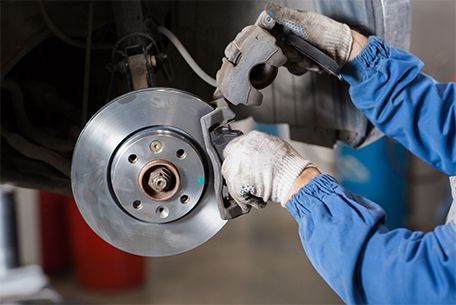Brake Rotor Replacement at Berkeley Bob's

What is a brake rotor and what does it do? The average driver knows that brakes are responsible for stopping a car. They also know they need to have them replaced every few years when they wear out. What they may know is brake replacement cost increases if the car needs to have the brake rotors replaced along with the brake pads. But what most people don’t know is exactly what the brake rotor does and why it would need replacement.
A brake rotor is a major component of the brake system. It is a heavy metal disc which provides a flat surface for the brake pads to clamp against when the brake pedal is depressed. The rotor is made out of a single forged piece of steel that is machined into a circular disc sometimes drilled on the surface to prevent excess heat from developing. The brake rotors along with the brake pads do the heaviest work of the brake system.
Every time the brake pad pedal is depressed the brake rotor is experiencing some degree of wear. Due to the nature of steel, it wears much slower than the brake pad friction material does. But none the less they do develop wear in the form of ridges caused by irregularities of the brake pad friction material or road debris caught between the surfaces while braking. Brake rotors are also susceptible to warping when the hot surface is repeatedly cooled quickly. An example would be driving down a steep hill where repeated braking has occurred then coming to a final stop at the bottom of a hill in a cool puddle of water. This can also happen when driving fast and braking hard, essentially overheating the brakes.
Volvo, Audi, SAVs, and SUVs all share similarities because of their weight. A heavier vehicle takes longer to stop and wears brakes down faster. Also, these vehicles tend to carry more passengers and gear which adds to the total weight. It is common for the heavier vehicles to need brake rotor replacement with every brake pad replacement. As mentioned the faster the vehicle goes the more wear on the brakes and more heat is generated by the friction of braking. This heat can add to irregularities on the brake rotor surface. When a technician sees grooves, hot spots or glazing on the rotor surface he recommends replacement. Glazing is caused when brake pad material fuses to the surface of the brake rotor, hot spots are created due to the metal components within the brake pad and it’s interaction with the metal of the brake rotor and grooves are caused by road debris or inconsistent brake pad material. Anyone of those causes is going to happen and are not the result of poor driving habits.
At Berkeley Bob's we do not resurface brake rotors on any vehicles we work on and we evaluate the brake rotor condition on every brake job. We use our judgment and expertise to determine if your car’s brake rotors will be able to provide quiet, safe, smooth and solid braking until the brake pads wear out again in another 3 to 6 years. Our experience has shown us thinner rotors are vulnerable to a condition called warping. Warping is an uneven surface condition that causes the brake pads to come in contact with only a portion of the brake rotor. A driver can feel a shuttering through the brake pedal when braking at high speeds. The industry has a standard minimum thickness for brake rotors. Turning the brake rotor on a lathe to remove some of the damaged material to attempt to flatten the surface, eliminate grooves or hot spots mean sometimes taking the rotor down below the legal limit which we won’t do. Berkeley drivers do their share of braking with traffic congestion, numerous stop signs, and steep hills. The automotive industry calls this type of driving condition severe. Naturally, intensive braking is required in severe driving conditions and this contributes to worn out brake rotors and increases the chances of resurfaced brake rotors to warp.
